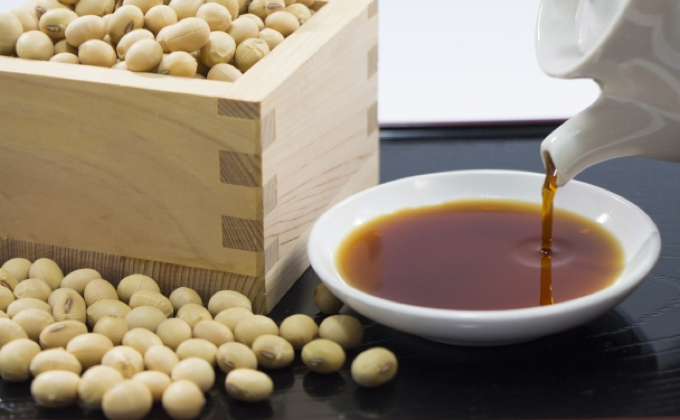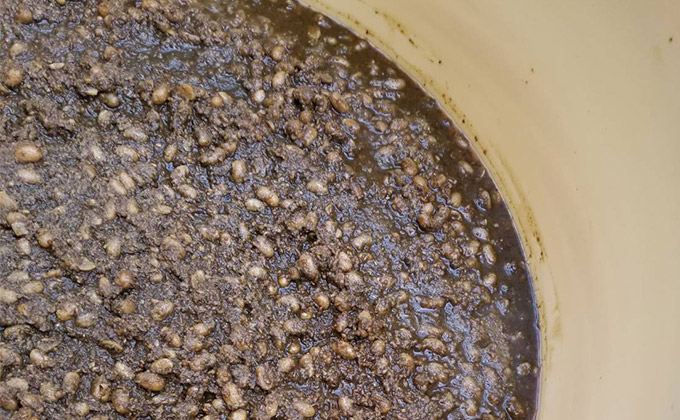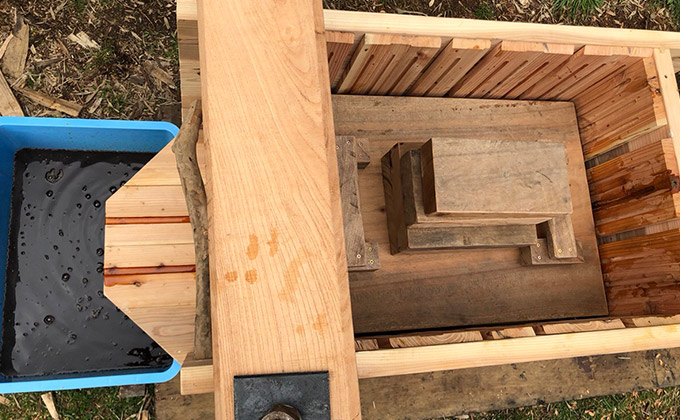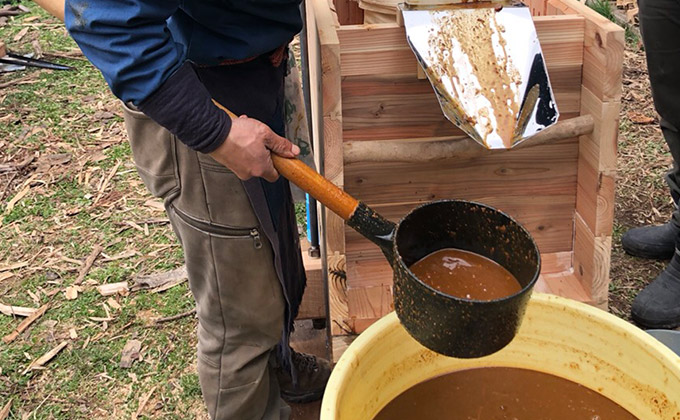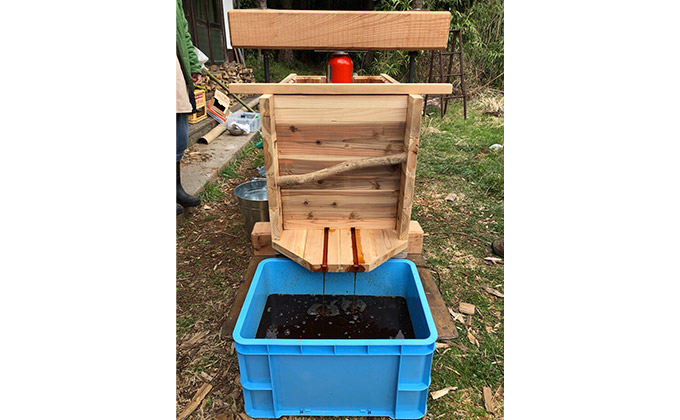TRG Info and Advice
Soy Sauce: The Other Black Gold
Are you a soy sauce connoisseur? I’m talking about more than just dipping your sushi in it! I used to think all soy sauce tasted like Kikkoman’s until I made my own. Now, I am officially on my way to becoming a fermento: a person who ferments food and is passionate about fermentation and live cultures!
Three years ago I was invited to make soy sauce with a couple of good friends. One had done it before, and also possessed a knack for these kinds of traditional, fermented things (a budding fermento). The other, like me, was pretty much clueless. Yet, what we lacked in knowledge, we made up for with enthusiasm, songs and gossip.
Day One, sometime in late April: Shikomi
The year-long process of making soy sauce started with a delivery of tane kouji. Our knowledgeable friend had made soy sauce the previous year, so she knew the necessary ingredients and ordered this most crucial one from a specialty shop in Nagano Prefecture. Tane kouji is actually a mixture of three ingredients: roasted and cracked wheat, steamed soybeans, and malt culture. We donned masks so as not to breathe in the powerful and powdery culture, dumped it out onto a clean tarp and began adding several kilos of salt. Once the appropriate amount of salt was measured out, we began mixing it all together with our (freshly washed) hands.
Among people who make their own fermented foods like miso and pickles, it is commonly thought that the personalized, natural bacteria on our hands is a crucial element in creating a taste perfectly suited to our families.
After the salt and tane kouji were thoroughly mixed, and before we began adding the water, we had to decide the perfect place to put our fifty-liter vat of budding black gold for the duration of the year! Space on a partially-roofed sundeck, which provided desired access to natural breezes, shade and sunlight, was proffered and accepted. So, we set up an out-of-the-way spot, poured the salt and kouji concoction into a large plastic tub (elevated for ventilation purposes on a couple of 2X4s) and began adding water. Each liter was carefully measured out to insure the correct ratio. Then we stirred it gently with a long bamboo stick until we had something that resembled a giant pot of chili. We covered the top of the tub with a soft mesh screen and secured it with a rope. Before putting on the lid, we put two more 2X4s across the top to allow for more ventilation. Then, the whole ensemble was topped with a large block of wood to keep the lid from blowing away. We brushed off our hands and set up a time to meet the next day.
Day Two: Tenchigaeshi
Gently removing the block of wood, lid, 2X4s and mesh, we leaned over the tub for a glimpse of our “baby.” The mixture didn’t look that different from the day before, but there was a slight accumulation of salt across the top. Today was the first day of tenchigaeshi, where the thick liquid (called moromi) is transferred from its “birth” tub to another tub and back again, being turned over and thoroughly rearranged in the transfer. Since a fifty-five liter tub can get pretty heavy, we had to move half of the mixture, then set up the new tub on the 2X4s before completing the transfer. We covered it up again and made arrangements to meet in three days to repeat the process.
Days Five, Eight, and Eleven
This time when we checked on our concoction, there was a thick and visible crust of salt covering the top. It crunched as we broke through and started to transfer the moromi back to its original tub. We were also surprised to find that the beans had separated rather dramatically from the water. We began to fret. Did we put in too much salt? Were the beans properly absorbing the liquid? One friend plucked out a bean and broke it in half. The inside looked like green cotton candy! Was that normal?!? We took pictures and posted them on a thread with other homemade soy sauce makers. Like a collective mom with a newborn, we questioned and examined the appearance of our creation thoroughly every three days until, around day eleven or so, we began to relax.
Girls’ Talk Soy Sauce
Once the moromi had progressed from a suspension mixture to a thoroughly blended one, our tenchigaeshi schedule changed from every three days to every week. We enjoyed these meetings like social excursions, chatting before and during, then having tea or coffee and snacks afterwards. In an effort to inspire our soy sauce to be the best, I made up a song to sing and included some of the foods I wished to consume with our (hopefully) delicious soy sauce.
Shouyu ha shouyu ha ummai yo!
(Soy sauce, oh soy sauce, you are scrumptious)
Oishikunare yo! (You must become delicious)
Sashimi ni tsukeru no mo mochiron yo!
(Of course, you are good with sashimi)
Avocado-mayo ni mo niau no yo!
(But you also go well with avocado and mayonnaise)
We (mostly I) sang while we stirred and transferred our budding soy sauce. We sampled the beans, which were now completely saturated, and made profound observations like: “stinky,” “immature,” and “salty.” Our conversation topics strayed from the activity at hand and ranged from childrearing troubles to squabbles with our significant others, but we whispered the more raucous comments, so as not to “turn” the soy sauce.
The Greenhouse Effect:
Weekly tenchigaeshi continued until it was officially summer (and not just according to the calendar). Now it was time to make the temperature of our moromi soar! We built a thin wooden frame, put the tub inside and wrapped the whole thing with a clear plastic sheet. Our fermento-in-charge’s deck, which had a clear, plastic roof, but with access to ample breezes, proved to be the perfect “laboratory.” Scorching summer days combined with our make-shift greenhouse helped to raise the temperature of our moromi to 45 degrees Celsius (113 degrees Fahrenheit).
From this point on, it was time to take a step back and let Mother Nature do her work, so our stir sessions were reduced to once a month. We observed changes in the consistency (chili con carne), color (greenish brown on the top, chili con carne once stirred), scent (soy sauce-y) and flavor (slowly developing), praying that all would go well and we wouldn’t end up with a giant tub of natto (a fermented soybean food often eaten for breakfast). Our absentee parenting allowed the beans a chance to slowly dissolve, without completely losing their shape.
Once, during a tenchigaeshi, I sampled a bean and was horrified to find that its flavor resembled a salty headed-to-the-compost melon rind. Occasionally, we discovered beans covered in a milky-white film and quickly removed them. Consultations with more knowledgeable fermentos assured us that this was a harmless mold. Progressively, the flavor matured to that of smoky bacon, and I began to believe that we were actually going to end up with something edible.
The Home Stretch: Shibori
As the seasons changed from sweltering summer to mild fall and then bone-chilling winter, we moved the moromi to an outer hallway in our chief’s home. We continued to stir and sample once a month, discovering that even though our toes were frozen, the temperature within the tub remained rather consistent thanks to the natural heat of the fermentation process.
Towards late March, we began preparing for the final step in the soy sauce making process: pressing or shibori. Several homemade soy sauce groups in our area banded together to bring an expert with his very own portable press to our remote island. He came on the ferry with his van so that he could transport his machinery, and assembled it in our friend’s yard: an impressive contraption made from perfectly balanced blocks of elm.
We filled about twenty hemp-linen bags with our still chili-like moromi, folded the bags in half lengthwise and layered them inside the elm box. Once everything was neatly stacked, a heavy piece of wood attached to a giant c-clamp was placed across the top and the pressing began. Lovely, dark maroon soy sauce trickled out from the stainless steel spout at the bottom of the box into a tub. When it became full, we transferred it to the large pot of water being heated by fire on an outdoor woodstove. This process continued for nearly an hour, with the block of wood at the top eventually being forced down with a car jack!
When the last bucketful of soy sauce was pronounced kijoyu, we grabbed small bottles we had brought from home especially for the purpose of retrieving this special, freshly-pressed, “raw” soy sauce. The rest of the soy sauce had been transferred to the fire-heated cauldron for pasteurization and, after being mixed and measured with boiled water to create the desired sodium ratio, was being heated to 70 degrees Celsius.
Tonight’s dinner menus would highlight the unique umami of kijoyu with udon noodles, cucumber salads, and maybe even some sashimi.
While some members carefully monitored the temperature, the rest of us began emptying out and washing the bags which had held our moromi and were now filled with the solid remains. These leftovers would be divided up among the three of us, and could be used for a variety of things from TVP (textured vegetable protein) and seasoning to fertilizer. Turning the bags inside out, we dumped the dregs into a large bucket, then did some old-fashioned scrubbing using three different washtubs.
Just as we were hanging out our “laundry,” the target temperature for the soy sauce being heated was achieved and we adjusted the fire to hold the liquid at 70 degrees for about thirty minutes. After moving the heated soy sauce back to its original tub, the next step was to let it cool and settle, allowing any remaining sediment to sink to the bottom. We covered it lightly with newspapers, tied it and left it in our friend’s entryway. Giddy with the anticipation of trying kijoyu, we headed home after arranging to meet again in a few days for the final step of bottling.
Bottling it Up: Binzume
We arrived on the appointed day, each lugging about ten isshobins (a large, usually green, glass bottle mostly used for Japanese sake, measuring 1.8 liters). Tying a small hose ten centimeters up from the bottom of a bamboo stick so that it would suck the soy sauce from above the lower layer of settled sediment, we roshamboed to see who would suck on the end of the hose just enough to get the siphoning going. Chief lost with a scissors to our rocks, then exhaled deeply before expertly calling up the liquid and quickly transferring the end of the hose into the first, awaiting bottle.
Chatting and swapping kijoyu recipes, we continued this process, occasionally adjusting the height of the hose when air bubbles appeared. When most of our bottles were filled, we noticed the liquid had become slightly cloudy and realized we were dipping into the bottom section of the tub. While still tasty, this last, sediment-heavy soy sauce must be kept in the refrigerator and is best used with cooked dishes, in place of consommé cubes for sauces or soups. We separated this last portion, therefore, into different bottles and labeled them accordingly.
My house has a kura storage space on the property, a small, two-story structure with mud walls that are extremely thick. It is the perfect place to keep things like rice, miso and soy sauce (and natural disaster backpacks), because the inside maintains a fairly consistent temperature and the building is meant to be fireproof. I happily stored my bottles of Joshikaijyoyu (girls’ talk soy sauce) and breathed a sigh of relief.
The final product of our efforts had a light flavor with undertones of dried bonito flakes (for some reason?!), and it went especially well with cucumbers.
My soy sauce would last us at least a year, with enough to share with family, friends and co-workers. In a few weeks, the next round of tane kouji was scheduled to arrive, and there had been some debate surrounding the best brand of salt for Joshikaijyoyu 2.0. Hopefully, the experiences of our first year would enrich the next batch.
Author’s Note: This is my twentieth year in Japan and I have lost count of the number of times I’ve been told that I’m more Japanese than Japanese people. In a country this rife with amazing culture, it is a shame that much of it is going out of style.
Well, I don’t want it going to waste on my watch, so I’ve continued to make soy sauce (currently in my fourth year!) and miso (sixth year) the old-fashioned way, and will try my hand at pickled plums in the near future. I also try to take advantage of every opportunity to wear a kimono and can dress my daughter, sons, husband and even myself in kimonos (albeit slightly imperfect). Showing up in a kimono at random events is a great way to get free ones that people feel guilty about keeping in storage!
I still balk at reading kanji-filled notices from schools and banks, however, have yet to master Japanese beyond that of an elementary school second-grader, and prefer wine to sake, but hey, I’ve still got time…






